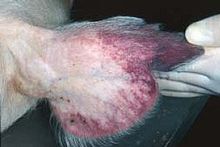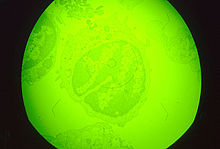African swine fever virus
Veterinary-medicine-swine-fever-Escherichia-coli-virus.html
| African swine fever virus | |
|---|---|
| File:African swine fever virus virion TEM.jpg | |
| Electron micrograph of a virus particle | |
| Virus classification | |
| Group: | Group I (dsDNA)
|
| Family: | |
| Genus: | |
| Species: | African swine fever virus
|
African swine fever virus (ASFV) is the causative agent of African swine fever (ASF). ASFV is a large, double-stranded DNA virus which replicates in the cytoplasm of infected cells, and is the only member of the Asfarviridae family.[1] ASFV infects domestic pigs, warthogs and bushpigs, as well as soft ticks (Ornithodoros), which are likely vectors. ASFV is the only virus with a DNA genome transmitted by arthropods. The virus causes a lethal haemorraghic disease in domestic pigs. Some isolates can cause death of animals within as little as a week after infection. In all other species, the virus causes no obvious disease. ASFV is endemic to sub-Saharan Africa and exists in the wild through a cycle of infection between ticks and wild pigs, bushpigs and warthogs. ASFV was first described after European settlers brought pigs into areas endemic with ASFV and, as such, is an example of an 'emerging infection'.
History
African swine fever was restricted to the continent that bears its name until 1957, when the disease was reported in Lisbon, Portugal. A further outbreak occurred there in 1960. Subsequent to these initial introductions, the disease became established in the Iberian peninsula and sporadic outbreaks occurred in France, Belgium and other European countries during the 1980s. Both Spain and Portugal had managed to eradicate the disease by the mid 1990s through a slaughter policy.
It has been alleged that, with at least the tacit backing of U.S. Central Intelligence Agency officials, operatives linked to anti-Castro terrorists introduced African swine fever virus into Cuba in 1971 for the purposes of destabilizing the Cuban economy and encouraging domestic opposition to Fidel Castro. The virus was allegedly delivered to the terrorists from an army base in the Panama Canal Zone by an unnamed US intelligence source. Six weeks later an outbreak of the disease forced the slaughter of 500,000 pigs to prevent a nationwide animal epidemic. The outbreak was labeled the "most alarming event" of 1971 by the United Nations Food and Agricultural Organization.[2][3][4] However, this claim only emerged six years after the original outbreak, and was made by the newspaper Newsday citing untraceable sources.[5][6] ASFV crossed the Atlantic Ocean and outbreaks were reported in some Caribbean islands, including the Dominican Republic. Major outbreaks of ASF in Africa are regularly reported to the World Organisation for Animal Health (previously called l'office international des épizooties (OIE)). The most recent outbreak of ASF outside Africa started at the beginning of 2007 in Georgia, and has since spread to the countries of Armenia, Azerbaijan, Iran and Russia.
The appearance of ASF in the Western hemisphere at the same time as the emergence of AIDS led to some interest in whether the two were related, and a report appeared in the Lancet supporting this in 1986.[citation needed] However, AIDS is now known to be caused by human immunodeficiency virus (HIV); no link between ASFV and AIDS has been proven or is suspected.
Symptoms

The clinical symptoms of ASF are very similar to classical swine fever virus, and the two diseases normally have to be distinguished by laboratory diagnosis.

Virus structure and replication

ASFV is a large, double-stranded DNA virus with a genome containing at least 150 genes. The number of genes differs slightly between different isolates of the virus. ASFV has similarities to the other large DNA viruses, e.g., poxvirus, iridovirus and mimivirus. In common with other viral haemorrhagic fevers, the main target cells for replication are those of monocyte, macrophage lineage. The virus causes a haemorrhagic fever with high mortality rates in pigs, but persistently infects its natural hosts, warthogs, bushpigs and soft ticks of the Ornithodoros genus, with no disease signs. The virus encodes enzymes required for replication and transcription of the genome, including elements of a base excision repair system, structural proteins and many proteins that are not essential for replication in cells, but have roles in virus survival and transmission in its hosts. Virus replication takes place in perinuclear factory areas. Assembly of the icosahedral capsid occurs on modified membranes from the endoplasmic reticulum. Products from proteolytically-processed polyproteins form the core shell between the internal membrane and the nucleoprotein core. An additional outer membrane is gained as particles bud from the plasma membrane. The virus encodes proteins that inhibit signalling pathways in infected macrophages and thus modulate transcriptional activation of immune response genes. In addition, the virus encodes proteins which inhibit apoptosis of infected cells to facilitate production of progeny virions. Viral membrane proteins with similarity to cellular adhesion proteins modulate interaction of virus-infected cells and extracellular virions with host components.[1]
Genotypes
Based on sequence variation in the C-terminal region of the p72 gene 22 genotypes have been identified.[7] Genotype VIII is confined to four East African countries.
See also
References
- ^ a b Dixon; et al. (2008). "African Swine Fever Virus". Animal Viruses: Molecular Biology. Caister Academic Press. ISBN 978-1-904455-22-6.
{{cite book}}: Explicit use of et al. in:|author=(help); External link in|chapterurl=|chapterurl=ignored (|chapter-url=suggested) (help) - ^ http://www.maebrussell.com/Health/CIA%20Pig%20Virus.html
- ^ http://www.historyisaweapon.com/defcon1/zinnseven20.html
- ^ http://www.centerforinquiry.net/blogs/entry/blowback_sf_chronicle_cia_introduced_swine_flu_in_cuba_to_weaken_castro/
- ^ Critical Reviews in Microbiology, 25(3):173–227 (1999) During the late 1970s
- ^ http://0-www.springerlink.com./index/t6km2034233172q8.pdf
- ^ Leblanc N, Cortey M, Fernandez Pinero J, Gallardo C, Masembe C, Okurut AR, Heath L, van Heerden J, Sánchez-Vizcaino JM, Ståhl K, Belák S (2012) Development of a suspension microarray for the genotyping of African swine fever virus targeting the SNPs in the C-terminal end of the p72 gene region of the Genome. Transbound Emerg Dis doi: 10.1111/j.1865-1682.2012.01359.x.
[1] Veterinary-medicine-african-swine-fever-risk-assessment-transport-trucks-waste-disposal.html==External links==
- OIE Animal Disease Data: http://www.oie.int/eng/maladies/fiches/a_A120.htm
- Institute for Animal Health Factfile: http://www.iah.ac.uk/disease/AfSwFe.shtml
- Department of Environment, Food and Rural Affairs Disease Factsheet: http://www.defra.gov.uk/animalh/diseases/notifiable/asf/index.htm
- ThePigSite.com: http://www.thepigsite.com/pighealth/article/441/african-swine-fever-asf
- CFIA Animal Disease Information
